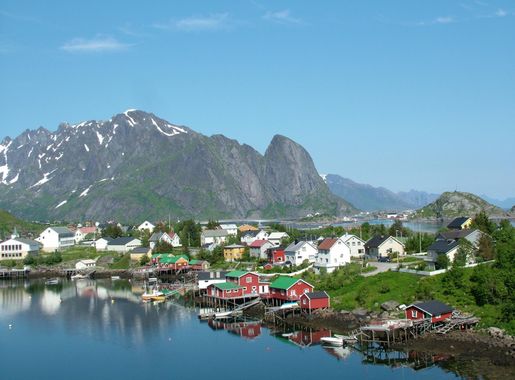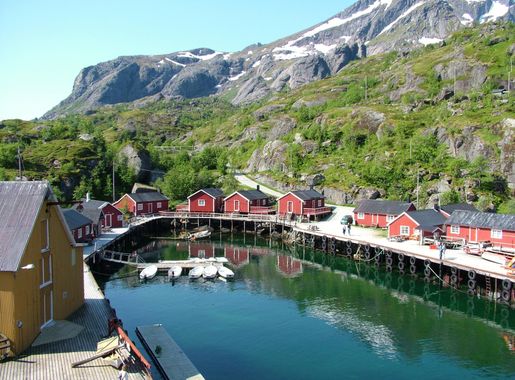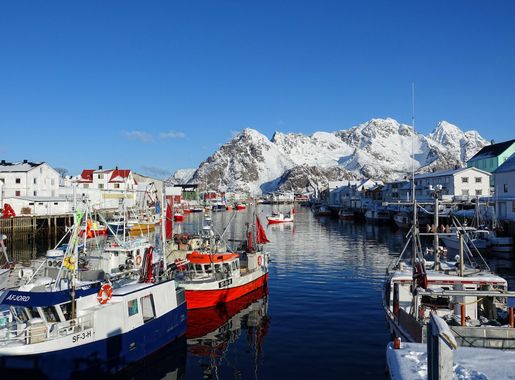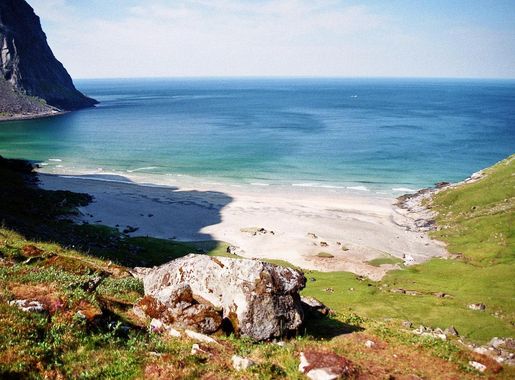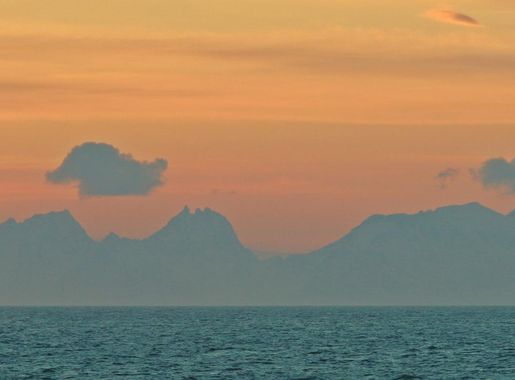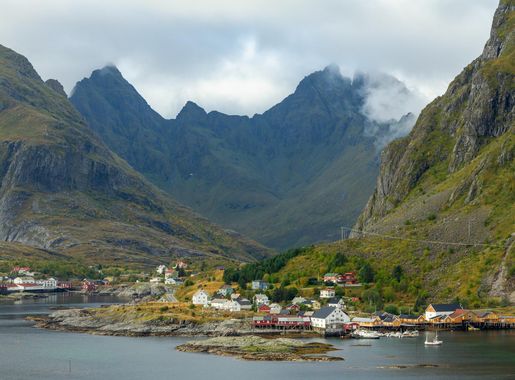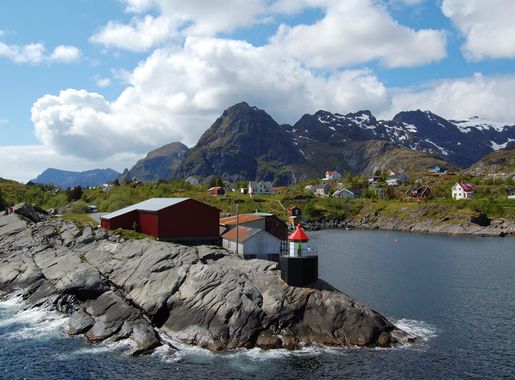
The Enchanting Lofoten Islands: Norway's Arctic Paradise
Discover the Lofoten Islands: Norway's Arctic Paradise, where dramatic landscapes, outdoor adventures, and rich cultural heritage await you in every season.
The Lofoten Islands, located in the Arctic Circle in Norway, are a dream destination for nature lovers and adventurers alike. Known for their dramatic peaks, sheltered bays, and untouched beaches, these islands offer some of the most stunning landscapes you will ever see. The blend of towering mountains, deep fjords, and small fishing villages creates a picturesque setting that feels almost otherworldly. One of the main attractions of Lofoten is its incredible midnight sun during the summer months, where the sun barely dips below the horizon, bathing the landscape in a golden glow. In winter, the islands transform into a snowy wonderland, and visitors can marvel at the Northern Lights dancing across the night sky. The islands provide a unique opportunity to experience both of these natural phenomena in the same location. Outdoor activities abound in Lofoten. Hiking is popular, with trails ranging from easy coastal walks to challenging summit climbs. The Reinebringen hike, in particular, offers panoramic views that are well worth the effort. For those who prefer the water, kayaking through the crystal-clear waters or surfing the Arctic waves are exhilarating options. Fishing, both sea and freshwater, is deeply rooted in Lofoten's culture, and you can even join a local fishing expedition to catch your own dinner. Lofoten's cultural heritage is also rich and inviting. Visit the charming fishing villages like Henningsvær and Nusfjord, where colorful wooden houses line the waterfront. The Lofotr Viking Museum provides a fascinating glimpse into the islands' Viking past, complete with reconstructed longhouses and traditional Viking feasts. Local art galleries and craft shops offer unique souvenirs, from hand-knitted garments to intricate glasswork. When it comes to cuisine, Lofoten does not disappoint. Fresh seafood is a staple, with cod, salmon, and Arctic char being local favorites. Dining in a traditional rorbu (fisherman's cabin) offers a cozy and authentic experience. Don't miss trying the stockfish, a dried fish delicacy that has been a part of Lofoten's culinary tradition for centuries.
Local tips in Lofoten Islands
- Visit during the summer for the midnight sun or in winter for the Northern Lights.
- Be prepared for changing weather; pack layers and waterproof clothing.
- Rent a car to explore the islands at your own pace, as public transport is limited.
- Book accommodations well in advance, especially during peak seasons.
- Try the local seafood dishes and stockfish for an authentic taste of Lofoten.
The Enchanting Lofoten Islands: Norway's Arctic Paradise
The Lofoten Islands, located in the Arctic Circle in Norway, are a dream destination for nature lovers and adventurers alike. Known for their dramatic peaks, sheltered bays, and untouched beaches, these islands offer some of the most stunning landscapes you will ever see. The blend of towering mountains, deep fjords, and small fishing villages creates a picturesque setting that feels almost otherworldly. One of the main attractions of Lofoten is its incredible midnight sun during the summer months, where the sun barely dips below the horizon, bathing the landscape in a golden glow. In winter, the islands transform into a snowy wonderland, and visitors can marvel at the Northern Lights dancing across the night sky. The islands provide a unique opportunity to experience both of these natural phenomena in the same location. Outdoor activities abound in Lofoten. Hiking is popular, with trails ranging from easy coastal walks to challenging summit climbs. The Reinebringen hike, in particular, offers panoramic views that are well worth the effort. For those who prefer the water, kayaking through the crystal-clear waters or surfing the Arctic waves are exhilarating options. Fishing, both sea and freshwater, is deeply rooted in Lofoten's culture, and you can even join a local fishing expedition to catch your own dinner. Lofoten's cultural heritage is also rich and inviting. Visit the charming fishing villages like Henningsvær and Nusfjord, where colorful wooden houses line the waterfront. The Lofotr Viking Museum provides a fascinating glimpse into the islands' Viking past, complete with reconstructed longhouses and traditional Viking feasts. Local art galleries and craft shops offer unique souvenirs, from hand-knitted garments to intricate glasswork. When it comes to cuisine, Lofoten does not disappoint. Fresh seafood is a staple, with cod, salmon, and Arctic char being local favorites. Dining in a traditional rorbu (fisherman's cabin) offers a cozy and authentic experience. Don't miss trying the stockfish, a dried fish delicacy that has been a part of Lofoten's culinary tradition for centuries.
When is the best time to go to Lofoten Islands?
Iconic landmarks you can’t miss
Lofotr Viking Museum
Explore the Viking era at Lofotr Viking Museum, where history comes alive through interactive exhibits, sailing experiences, and authentic Viking feasts.

Reinebringen
Discover the stunning vistas and exhilarating hikes at Reinebringen, a must-visit destination in Norway's breathtaking Lofoten Islands.
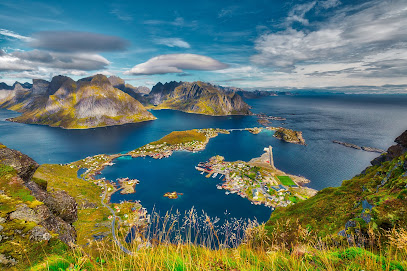
Magic Ice Lofoten
Discover the enchanting Magic Ice Lofoten in Svolvær, a unique ice gallery showcasing stunning sculptures and a cozy bar experience.
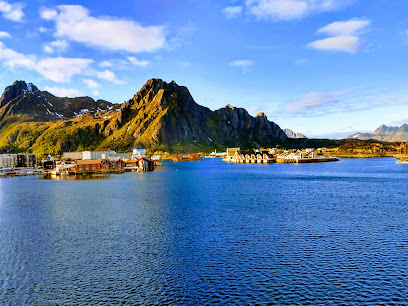
Uttakleiv strand
Discover the breathtaking Uttakleiv Strand, a hidden beach gem in the Lofoten Islands, perfect for relaxation, adventure, and stunning sunsets.
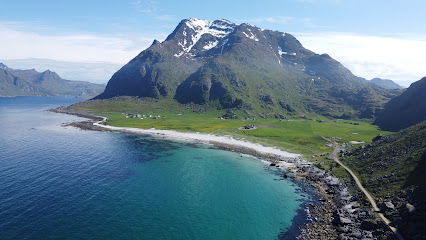
Lofotakvariet - The Lofoten Aquarium
Experience the enchanting Lofotakvariet, an aquarium showcasing the diverse marine life of Norway's Lofoten Islands, perfect for families and nature lovers.
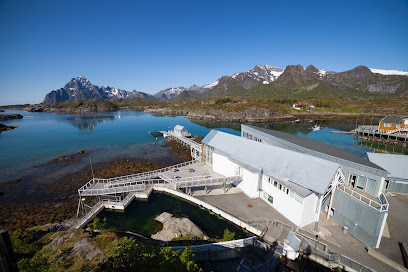
Viewpoint at Å
Discover the stunning landscapes at the Viewpoint at Å, a top destination for breathtaking views and serene nature in Norway.

Lofoten Harbour, Leknes
Explore the enchanting Lofoten Harbour in Leknes, a hub for souvenirs, bicycle rentals, and breathtaking sightseeing tours in the stunning Lofoten Islands.
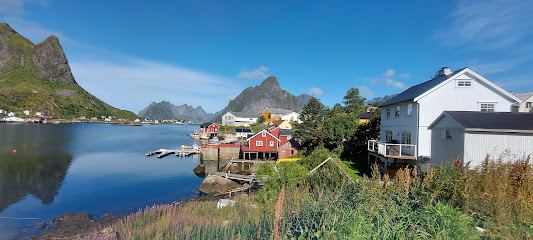
Kvalvika Beach
Discover the serene beauty of Kvalvika Beach, a hidden gem in the Lofoten Islands, offering breathtaking landscapes and tranquil escape.
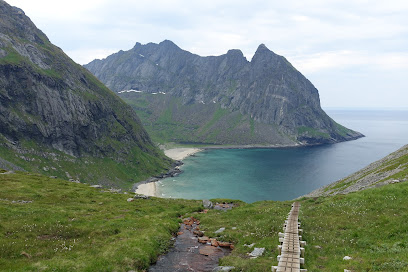
Nusfjord
Discover the charm of Nusfjord, a UNESCO World Heritage site in Norway's Lofoten Islands, where tradition meets stunning natural beauty.
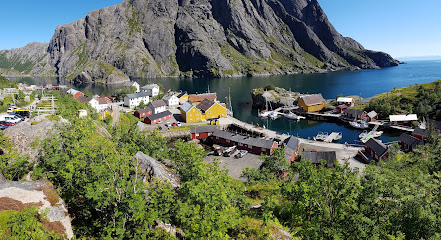
Lofoten War Memorial Museum
Explore the poignant history of World War II at the Lofoten War Memorial Museum in Svolvær, where stories and artifacts come to life.
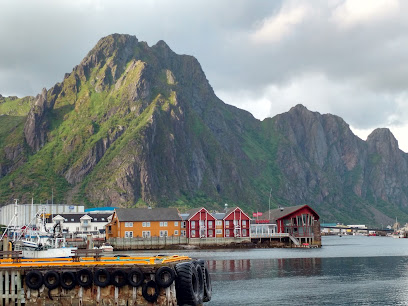
Norwegian Fishing Village Museum Å
Explore the rich maritime heritage at the Norwegian Fishing Village Museum in Å, showcasing the historical significance of fishing in coastal Norway.
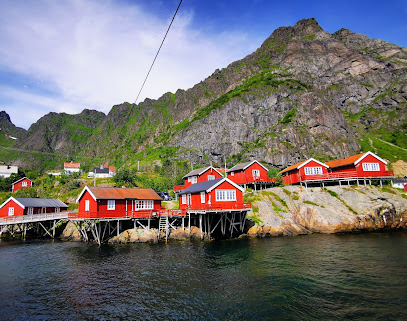
Nusfjord - Historical Fishing Village
Discover the charm of Nusfjord, a historical fishing village that offers a unique glimpse into Norway's maritime heritage amidst stunning natural beauty.
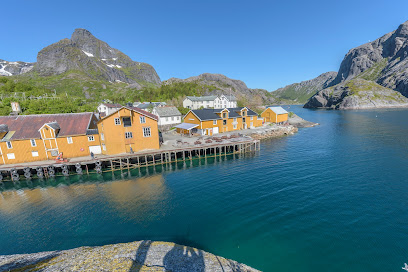
Lofoten Tørrfiskmuseum
Explore Norway's fishing heritage at the Lofoten Tørrfiskmuseum, where tradition and culture come alive in the heart of the stunning Lofoten Islands.
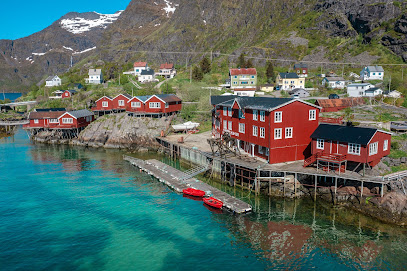
The Blacksmith at Sund
Explore the artistry and tradition of blacksmithing at The Blacksmith at Sund, a unique museum in Ramberg, Norway, showcasing exquisite metalwork.
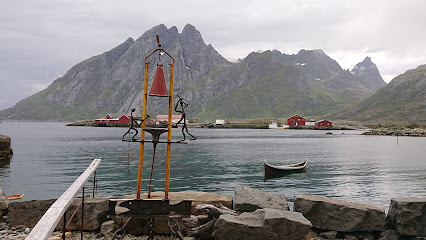
Offersøykammen
Explore Offersøykammen, a breathtaking hiking area in Norway renowned for its stunning views and vibrant nature, perfect for outdoor enthusiasts.
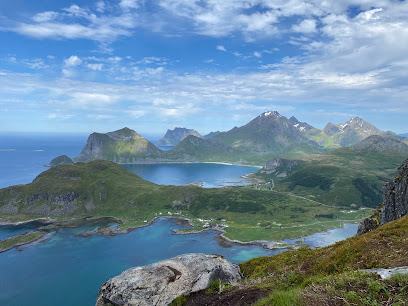
Unmissable attractions to see
Lofotr Viking Museum
Explore the Viking era at Lofotr Viking Museum, where history, culture, and adventure blend seamlessly in Norway's breathtaking landscapes.
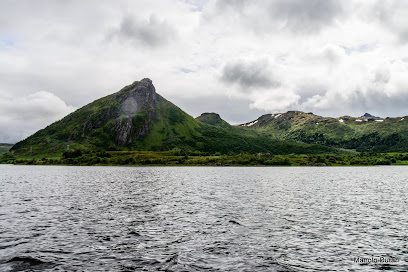
Reinebringen
Explore Reinebringen, a hiker's haven in Norway, where breathtaking views and stunning landscapes await every adventurous traveler.
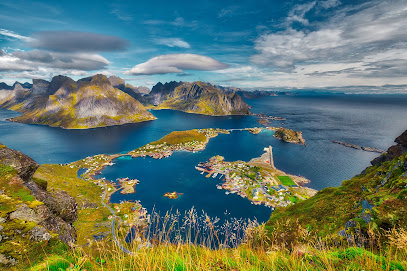
Uttakleiv strand
Discover the tranquility of Uttakleiv Strand, a stunning beach in the Lofoten Islands, where nature's beauty meets serene coastal relaxation.
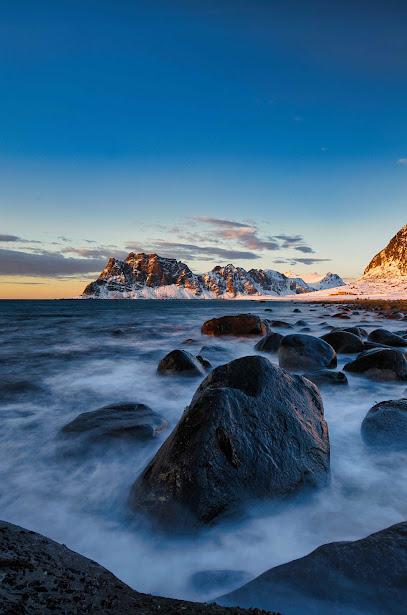
Uttakleiv strand
Explore Uttakleiv Strand: A hidden beach paradise on the Lofoten Islands with stunning rock formations and serene coastal beauty.
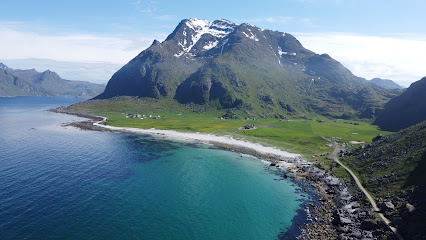
Lofotakvariet - The Lofoten Aquarium
Explore the Lofoten Aquarium, a vibrant showcase of Norway's marine life and conservation efforts in the stunning Lofoten Islands.
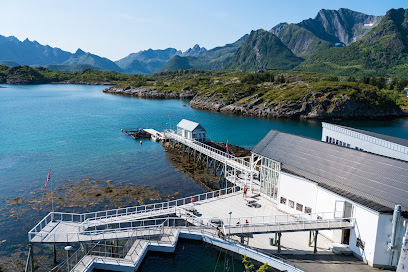
Viewpoint at Å
Discover the stunning Å Viewpoint in Sørvågen, Norway, where breathtaking landscapes and serene beauty await every traveler.
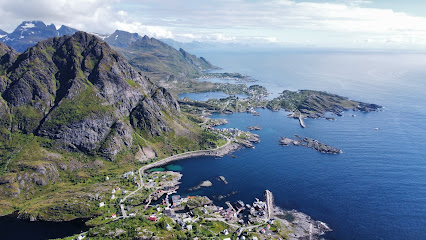
Lofoten Harbour, Leknes
Explore Lofoten Harbour in Leknes: a picturesque hub for local souvenirs, bicycle rentals, and unforgettable sightseeing tours in the stunning Lofoten Islands.
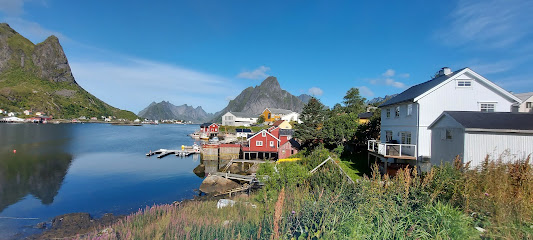
Nusfjord
Discover the enchanting fishing village of Nusfjord, a UNESCO World Heritage site that blends breathtaking nature with rich Norwegian culture.
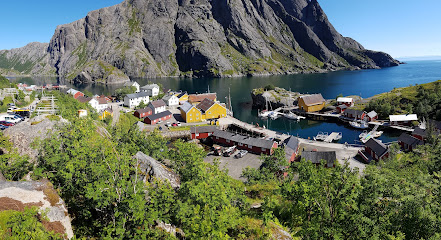
Norwegian Fishing Village Museum Å
Explore Norway's maritime culture at the Norwegian Fishing Village Museum in Å, showcasing the history and heritage of fishing communities in the Lofoten Islands.
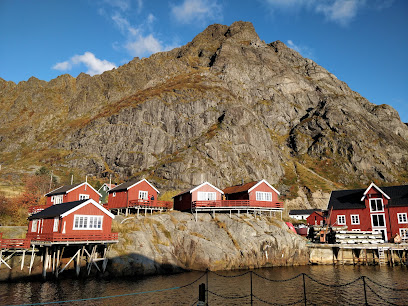
Vik Beach
Discover the stunning landscapes and tranquil beauty of Vik Beach, a must-visit destination on the Lofoten Islands in Norway.
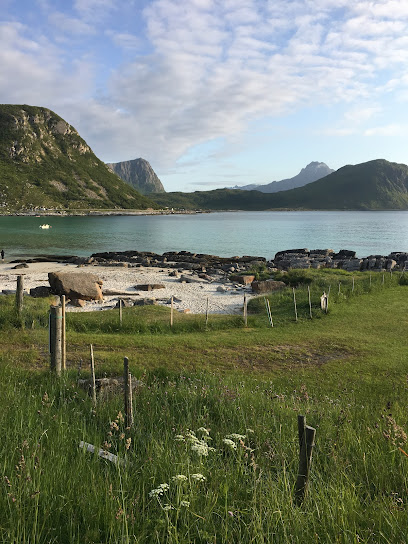
Festvågtind
Explore Festvågtind, a breathtaking hiking area in Henningsvær, Norway, renowned for its stunning views and unforgettable adventure.
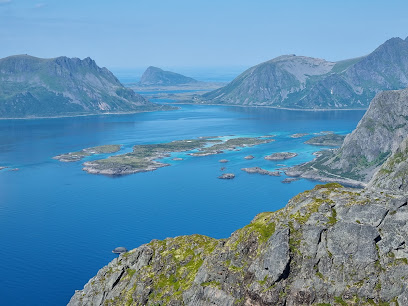
Nusfjord - Historical Fishing Village
Explore the enchanting Nusfjord, a historical fishing village in Lofoten, where maritime heritage meets stunning natural beauty.
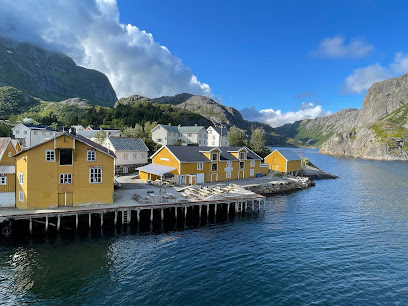
Henningsvær Port Viewpoint
Discover stunning views and serene landscapes at Henningsvær Port Viewpoint, a must-visit destination in the breathtaking Lofoten archipelago.
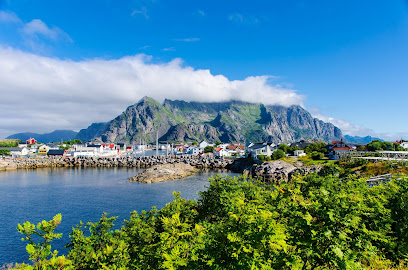
The Blacksmith at Sund
Discover the art of blacksmithing and immerse yourself in Norway's rich craftsmanship at The Blacksmith at Sund, a unique museum experience.
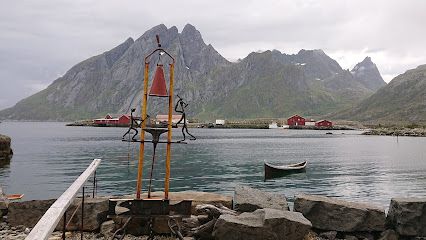
Offersøykammen
Experience the breathtaking landscapes of Offersøykammen, a top hiking destination near Leknes, Norway, perfect for nature lovers and adventure seekers.
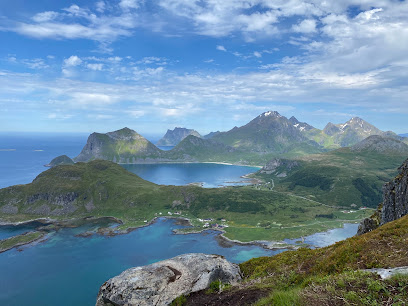
Essential places to dine
Bacalao
Experience authentic Norwegian cuisine at Bacalao in Svolvær – where fresh ingredients meet stunning views.
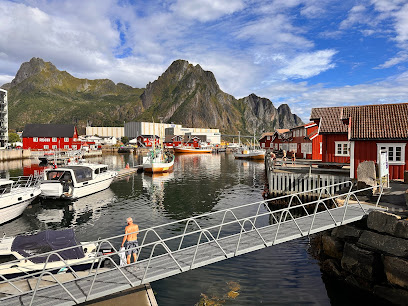
Fellini Lofoten As
Experience authentic Italian cuisine at Fellini Lofoten - where delicious pizzas meet breathtaking views in Svolvær.
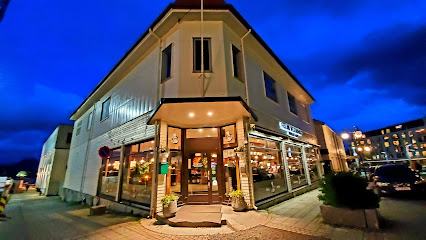
Nordis Restaurant Svolvær
Experience local cuisine at Nordis Restaurant in Svolvær – where every dish tells the story of Norway's rich culinary heritage.
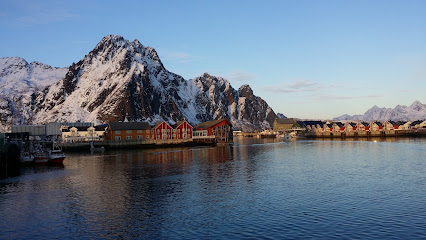
Maren Anna
Discover authentic Norwegian flavors at Maren Anna in Sørvågen – where stunning views meet exceptional cuisine.
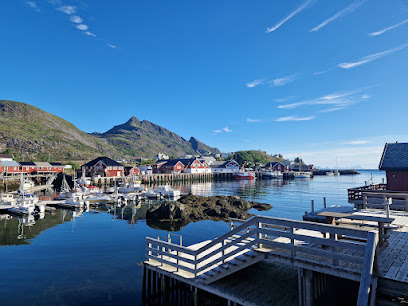
Restaurant Nihao Lofoten
Discover authentic Chinese cuisine at Restaurant Nihao Lofoten in Svolvær – where culinary tradition meets Norwegian charm.
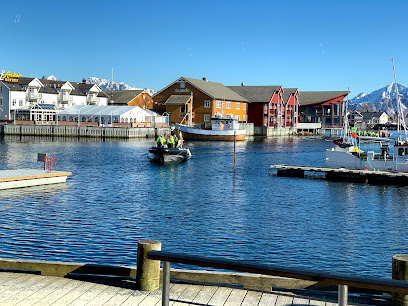
Klatrekaféen
Discover Klatrekaféen in Henningsvær - where exquisite burgers meet breathtaking views in Norway's picturesque fishing village.
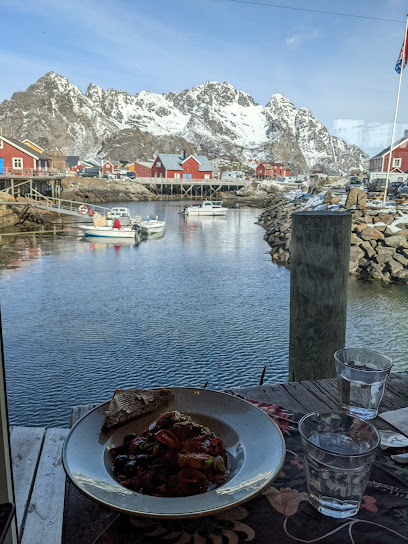
Børsen Spiseri
Experience authentic Norwegian cuisine at Børsen Spiseri in Svolvær, where fresh local ingredients meet stunning harbor views.
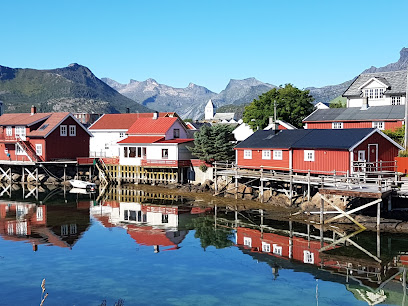
Brygga Restaurant & Bar - Lofoten
Experience exquisite meat dishes at Brygga Restaurant & Bar in Lofoten, where local flavors meet stunning views.
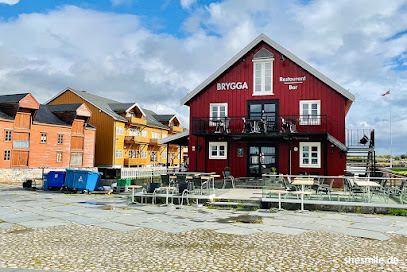
Karoline Restaurant
Experience authentic Norwegian cuisine amidst stunning fjord views at Karoline Restaurant in Nusfjord.
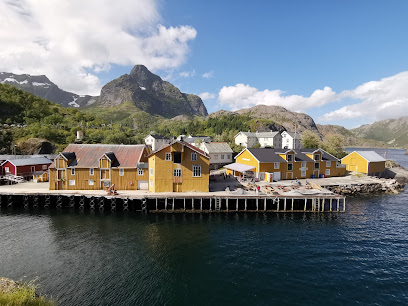
Digg Lofoten • Restaurant & Bar
Experience authentic Norwegian cuisine at Digg Lofoten Restaurant & Bar in Leknes—where local flavors meet stunning views.

Restaurant Gammelbua
Experience exquisite Norwegian cuisine in the heart of Reine at Restaurant Gammelbua - where local flavors meet breathtaking views.
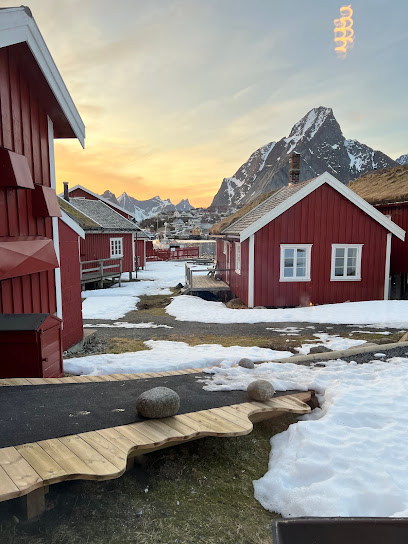
Brygga Restaurant
Discover Brygga Restaurant in Å – where exquisite Norwegian flavors meet stunning views.

Gadus
Experience authentic Lofoten seafood at Gadus - where every meal is a celebration of local flavors amidst stunning fjord views.
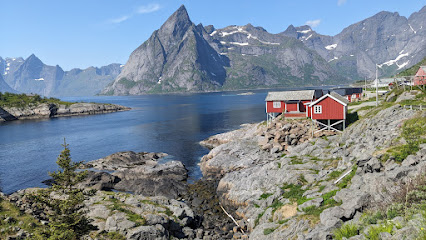
Underhuset
Experience authentic Norwegian cuisine at Underhuset in Reine – where breathtaking views meet delectable flavors.
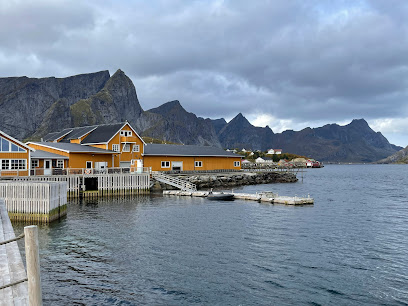
Restaurant The Kitchen
Experience exquisite Norwegian cuisine at The Kitchen in Svolvær with breathtaking views and a warm atmosphere.
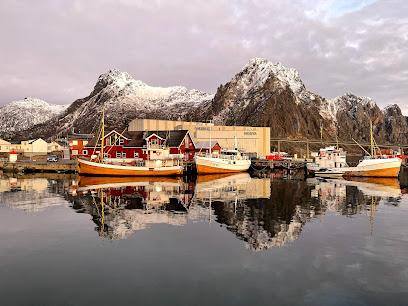
Markets, malls and hidden boutiques
Lofotr Viking Museum
Discover the Viking heritage at Lofotr Viking Museum, where history comes alive with immersive exhibits and authentic experiences in breathtaking Norway.
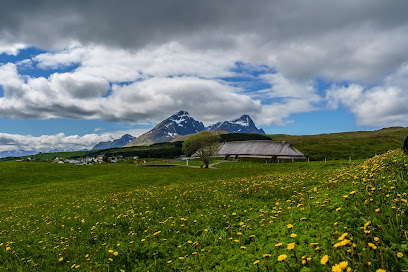
Lofotsenteret
Explore Lofotsenteret in Leknes for an unforgettable shopping experience amidst the breathtaking beauty of the Lofoten Islands.
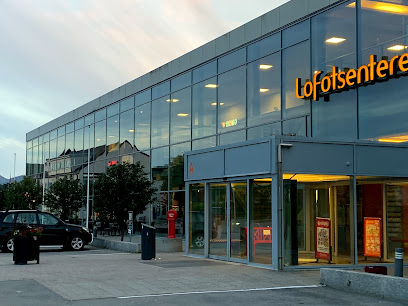
Alti Svolvær
Explore Alti Svolvær: A shopping paradise in the heart of the Lofoten Islands, where local culture meets modern retail experiences.
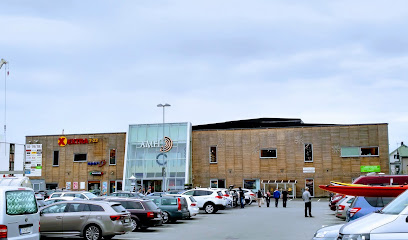
Lofoten Harbour, Leknes
Explore Lofoten Harbour in Leknes, a stunning destination for souvenirs, bicycle rentals, and unforgettable sightseeing adventures amidst breathtaking landscapes.
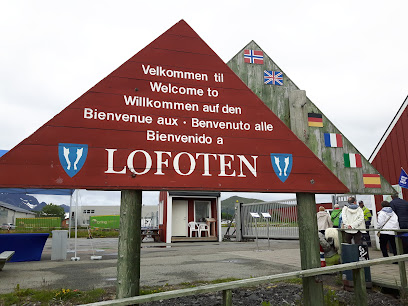
Bunnpris & Gourmet Leknes
Discover local flavors at Bunnpris & Gourmet Leknes, your go-to grocery store in Leknes for fresh produce and gourmet treats.
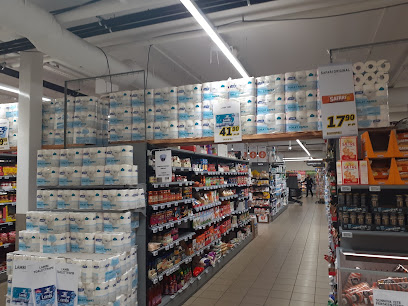
Lofoten Gårdsysteri
Savor the authentic flavors of Lofoten at Lofoten Gårdsysteri, a charming dairy store and cafeteria in Norway's breathtaking landscape.
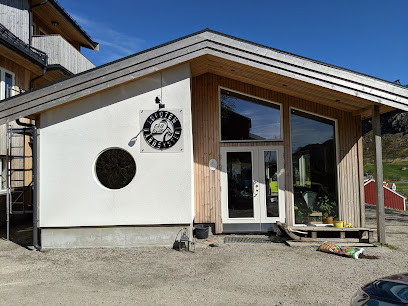
JYSK Leknes
Explore JYSK Leknes for stylish and affordable home furnishings, bedding, and outdoor furniture in the heart of Leknes, Norway.

Lofoten Sports And Leisure As
Explore the best of Lofoten's outdoors with quality gear from Lofoten Sports and Leisure, your premier sporting goods destination in Norway.

Lofoten Gaver og Brukskunst
Explore Lofoten Gaver og Brukskunst for unique local crafts, bicycle rentals, and unforgettable souvenirs from the breathtaking Lofoten Islands.
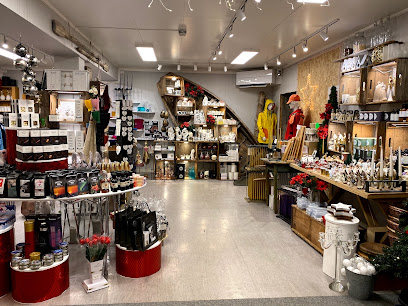
Lofoten Seaweed
Explore the health benefits and culinary versatility of seaweed at Lofoten Seaweed, a premier destination for organic and natural goods in Norway.
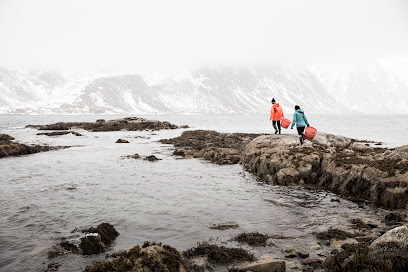
INTERSPORT
Explore the ultimate selection of sporting goods and accessories at INTERSPORT in Leknes, where quality meets adventure.
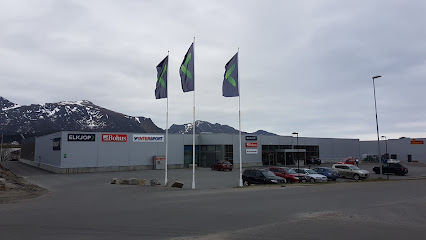
Lofoten Surfsenter
Experience the thrill of surfing in the breathtaking Lofoten Islands at Lofoten Surfsenter, your destination for adventure and unforgettable memories.
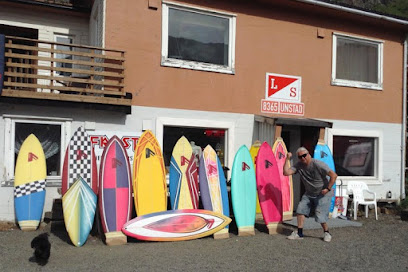
Gretes Håndarbeid AS
Explore the vibrant world of crafts at Gretes Håndarbeid AS in Leknes, your one-stop shop for yarn, fabrics, and sewing supplies.
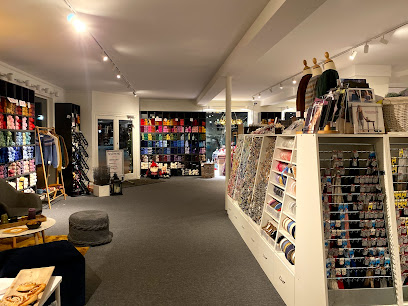
Lofotsportbua
Explore the Lofoten Islands with top-notch gear from Lofotsportbua, your local sporting goods store in Reine, Norway.
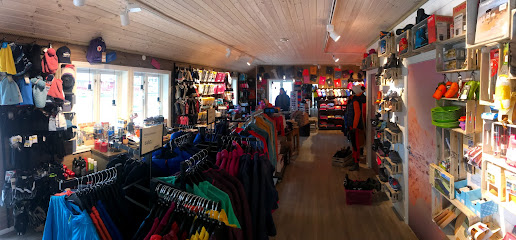
Cubus
Discover the latest fashion trends at Cubus, a premier clothing store in Leknes with stylish apparel for all ages.
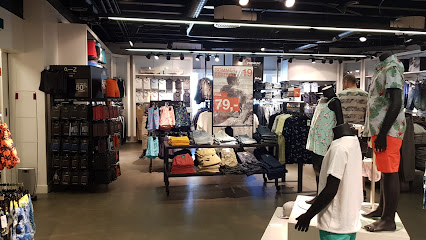
Essential bars & hidden hideouts
Bacalao
Experience the vibrant culinary scene of Svolvær at Bacalao, where local flavors meet a cozy atmosphere in the heart of the Lofoten Islands.
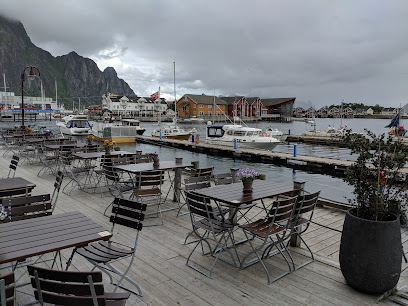
Magic Ice Lofoten
Discover the magic of ice artistry at Magic Ice Lofoten, a unique bar and art gallery in Svolvær, Norway, where creativity meets a chill atmosphere.
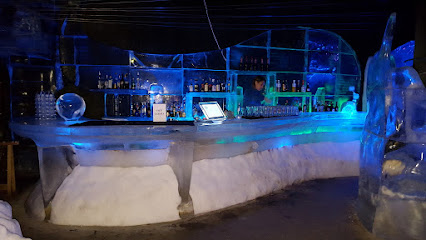
Nordis Restaurant Svolvær
Experience the best of Svolvær's culinary delights at Nordis Restaurant, where local flavors meet international cuisine in a charming setting.
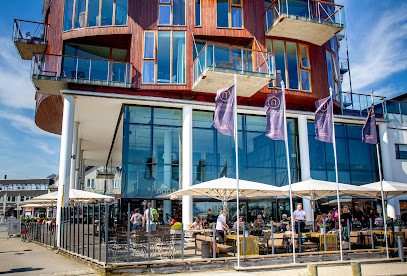
Klatrekaféen
Experience the flavors of Norway at Klatrekaféen, where delightful cuisine meets breathtaking views in Henningsvær.
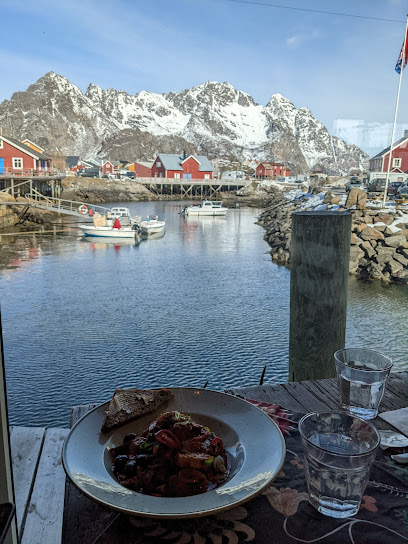
Børsen Spiseri
Experience the best of Norwegian cuisine with stunning views at Børsen Spiseri in Svolvær, a gourmet destination for food lovers.
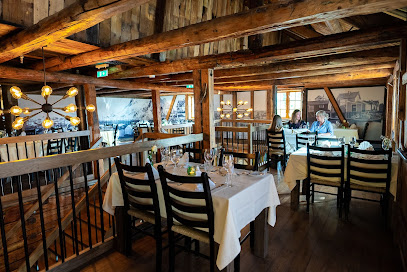
Anker Brygge
Discover Anker Brygge in Svolvær, where stunning landscapes meet exceptional hospitality in the heart of the Lofoten Islands.

Brygga Restaurant & Bar - Lofoten
Experience the best of Norwegian cuisine at Brygga Restaurant & Bar in Kabelvåg, where local flavors and stunning fjord views create an unforgettable dining experience.
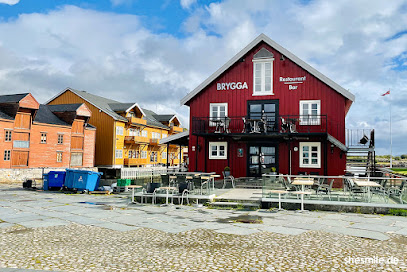
Digg Lofoten • Restaurant & Bar
Experience the authentic taste of Norway at Digg Lofoten Restaurant & Bar in Leknes, where local ingredients meet culinary creativity.
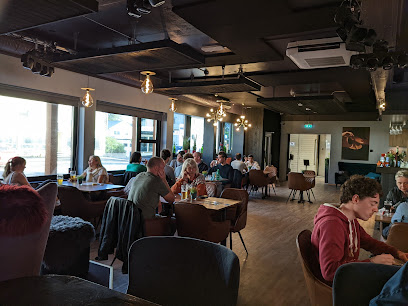
Restaurant Gammelbua
Experience exquisite local cuisine at Restaurant Gammelbua, nestled in the stunning landscapes of Norway's Lofoten Islands.
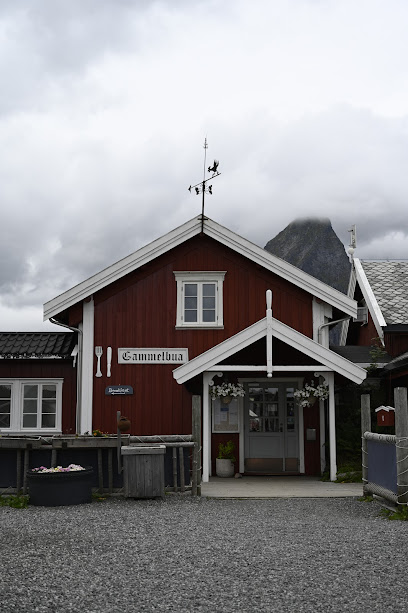
Brygga Restaurant
Experience authentic Norwegian cuisine at Brygga Restaurant in Å, where fresh ingredients meet stunning waterfront views.
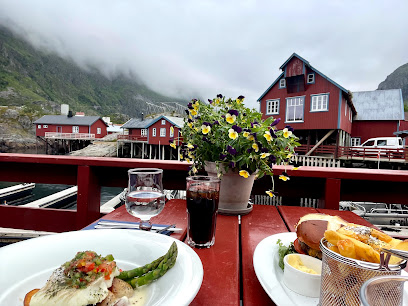
The tide hotel
Experience the beauty and flavors of Norway at The Tide Hotel in Sørvågen, where comfort meets adventure in a stunning landscape.

Styrhuset Pub
Experience local culture and craft brews at Styrhuset Pub in Svolvær, a cozy retreat perfect for tourists seeking relaxation and socializing.

Paleo Arctic
Explore the rich flavors of Norwegian cuisine at Paleo Arctic, where local ingredients meet traditional culinary artistry in a stunning Lofoten setting.
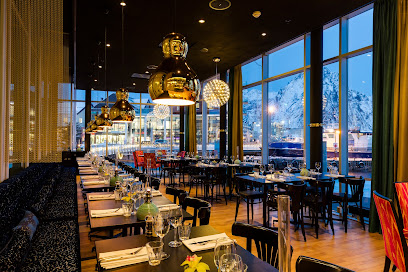
Lofoten Værøy Brygge
Experience the breathtaking beauty and culinary delights of Lofoten Værøy Brygge, a gem in Norway's stunning Lofoten Islands.
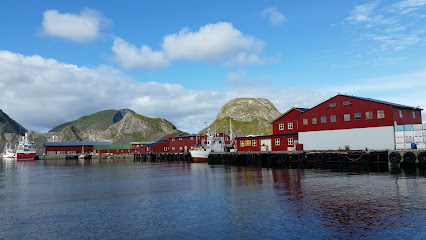
Live Lofoten Restaurant
Experience the culinary delights of Live Lofoten Restaurant, where local flavors meet stunning views in the heart of Stamsund, Norway.
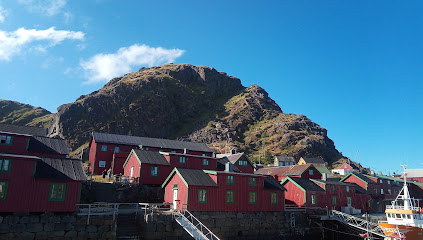
Local Phrases about Lofoten Islands
-
- HelloHei
[hay] - GoodbyeHa det
[ha deh] - YesJa
[yah] - NoNei
[nay] - Please/You're welcomeVær så snill
[vair soh snil] - Thank youTakk
[tahk] - Excuse me/SorryUnnskyld
[oonskild] - How are you?Hvordan har du det?
[vohr-dahn har doo deh] - Fine. And you?Bra. Og du?
[bra oh doo] - Do you speak English?Snakker du engelsk?
[snak-ehr doo eng-ehlsk] - I don't understandJeg forstår ikke
[yay for-stor eek-teh]
- HelloHei
-
- I'd like to see the menu, pleaseJeg vil gjerne se menyen, takk
[yay veer yern-eh seh meh-nyen, tahk] - I don't eat meatJeg spiser ikke kjøtt
[yay spee-ser eek-teh shøtt] - Cheers!Skål!
[skohl] - I would like to pay, pleaseJeg vil gjerne betale, takk
[yay veer yern-eh beh-tah-leh, tahk]
- I'd like to see the menu, pleaseJeg vil gjerne se menyen, takk
-
- Help!Hjelp!
[yelp] - Go away!Gå vekk!
[goh vehk] - Call the Police!Ring politiet!
[ring poh-lee-tee-et] - Call a doctor!Ring en lege!
[ring en leh-geh] - I'm lostJeg er lost
[yay ehr lost] - I'm illJeg er syk
[yay ehr sook]
- Help!Hjelp!
-
- I'd like to buy...Jeg vil kjøpe...
[yay veer shø-peh] - I'm just lookingJeg bare ser
[yay bah-reh seer] - How much is it?Hvor mye koster det?
[vohr my-eh kost-ehr deh] - That's too expensiveDet er for dyrt
[deh ehr for deert] - Can you lower the price?Kan du senke prisen?
[kan doo sehn-keh prees-ehn]
- I'd like to buy...Jeg vil kjøpe...
-
- What time is it?Hva er klokka?
[vah ehr klok-kah] - It's one o'clockKlokka er ett
[klok-kah ehr eht] - Half past (10)Halv ti
[hahlv tee] - MorningMorgen
[mohr-gehn] - AfternoonEttermiddag
[et-tehr-meed-dahg] - EveningKveld
[kveld] - YesterdayI går
[ee gohr] - TodayI dag
[ee dahg] - TomorrowI morgen
[ee mohr-gehn] - 1En
[en] - 2To
[too] - 3Tre
[tre] - 4Fire
[feer] - 5Fem
[fem] - 6Seks
[seks] - 7Syv
[siv] - 8Åtte
[oh-teh] - 9Ni
[nee] - 10Ti
[tee]
- What time is it?Hva er klokka?
-
- Where's a/the...?Hvor er en/et...?
[vohr ehr en/et] - What's the address?Hva er adressen?
[vah ehr ah-dress-ehn] - Can you show me (on the map)?Kan du vise meg (på kartet)?
[kan doo vee-seh may (poh kahr-teh)] - When's the next (bus)?Når går den neste (bussen)?
[nar gohr dehn neh-steh (boos-sehn)] - A ticket (to ....)En billett (til ....)
[en bee-let (teel)]
- Where's a/the...?Hvor er en/et...?
History of Lofoten Islands
-
The Lofoten Islands have a rich Viking heritage dating back to around 800-1100 AD. The islands were a significant center for the Vikings, who were known for their seafaring skills. Excavations at Borg on Vestvågøy have revealed the largest known Viking longhouse, measuring 83 meters in length. This longhouse is now part of the Lofotr Viking Museum, where visitors can explore reconstructed Viking buildings and learn about their way of life.
-
During the late Middle Ages, the Lofoten Islands became integral to the Hanseatic League, a powerful economic and defensive alliance of merchant guilds and market towns. The archipelago's location made it a crucial point for the trade of stockfish (dried cod), which was highly sought after in Europe. This period saw the rise of fishing villages and trading posts, some of which have evolved into the modern towns scattered across the islands today.
-
From the 12th century onwards, the stockfish trade played a vital role in shaping Lofoten's economy and culture. The unique climatic conditions of the islands made them ideal for drying fish, and stockfish from Lofoten was exported throughout Europe. This trade brought wealth and influenced the local culture, evident in the traditional rorbu cabins that were built to house fishermen during the fishing season. These cabins are now popular accommodations for tourists.
-
During World War II, the Lofoten Islands were occupied by German forces. The strategic importance of the islands led to several military confrontations, including the famous Operation Claymore in March 1941, when British commandos raided the islands. The raid was a success, resulting in the destruction of German installations and the capture of several prisoners. Today, remnants of wartime bunkers and fortifications can still be found across the islands, serving as a poignant reminder of this tumultuous period.
-
The fisheries of Lofoten have been the backbone of the islands' economy for centuries. The annual Lofoten Fishery, which takes place from January to April, attracts fishermen from all over Norway. The islands' waters are rich in Arctic cod, which migrate to the area to spawn. This fishing tradition has deeply influenced the local culture, as seen in the numerous festivals, museums, and seafood cuisine that celebrate Lofoten's maritime heritage.
-
In recent decades, the Lofoten Islands have become a popular destination for tourists seeking natural beauty and outdoor adventures. The stunning landscapes, characterized by dramatic mountains, deep fjords, and pristine beaches, have drawn visitors from around the world. Tourism has become a significant part of the local economy, with activities such as hiking, fishing, kayaking, and Northern Lights viewing offering unique experiences. The blend of natural allure and cultural heritage continues to make Lofoten a captivating destination.
Lofoten Islands Essentials
-
The Lofoten Islands are located in northern Norway and can be accessed by several means. The nearest airport is Leknes Airport (LKN), which offers flights from major Norwegian cities such as Oslo and Bodø. Another option is Svolvær Airport (SVJ), which also connects to these cities. If you prefer traveling by sea, there are ferries from Bodø to Moskenes, Værøy, and Røst. Additionally, Hurtigruten coastal cruises stop in Stamsund and Svolvær. For those driving, the E10 highway connects the islands to the mainland.
-
Within the Lofoten Islands, public transportation options include buses operated by the public transportation company, Nordland fylkeskommune. Buses connect the main towns and villages, but service can be infrequent, especially on weekends. Renting a car is highly recommended for flexibility and convenience. Bicycling is another popular way to explore the islands, especially in the summer. Taxis are available but can be quite expensive.
-
The official currency in Norway is the Norwegian Krone (NOK). Credit and debit cards are widely accepted in most establishments, including restaurants, hotels, and shops. However, it's advisable to carry some cash for small purchases or in more remote areas where card payment might not be available. ATMs are available in the larger towns like Svolvær and Leknes.
-
The Lofoten Islands are generally very safe for tourists, with low crime rates. Petty crime such as pickpocketing is rare but can occur in crowded areas, so it is advisable to keep an eye on your belongings. There are no specific high-crime areas targeting tourists. Always follow local regulations, especially regarding outdoor activities, to ensure your safety.
-
In case of emergency, dial 112 for immediate assistance, which covers police, fire, and medical emergencies. The main hospitals are located in Gravdal and Stokmarknes, while smaller medical clinics can be found in towns like Svolvær and Leknes. It is highly recommended to have travel insurance that covers medical emergencies. Pharmacies are available in the larger towns for minor health issues and over-the-counter medications.
-
Fashion: Do dress in layers and bring waterproof and windproof clothing due to the unpredictable weather. Avoid wearing flashy or overly revealing attire. Religion: Do respect local customs and traditions. While Norway is largely secular, churches should be visited with respect and quiet demeanor. Public Transport: Do be punctual, as buses run on a strict schedule. Don’t eat or drink on public transport. Greetings: Do greet people with a firm handshake and maintain eye contact. A simple 'Hei' (Hi) or 'God dag' (Good day) is customary. Eating & Drinking: Do try local delicacies like stockfish and cod. Don’t refuse food when offered, as it is considered impolite.
-
To experience Lofoten Islands like a local, consider staying in a 'rorbu,' a traditional fisherman's cabin, which offers a unique and authentic experience. Engage in local activities such as fishing, hiking, and kayaking. Visit local markets to buy fresh seafood and artisanal products. Don't miss the opportunity to see the Northern Lights in winter or the Midnight Sun in summer. For a quieter experience, explore the smaller villages like Henningsvær and Nusfjord.
Trending Landmarks in Lofoten Islands
-
Lofotr Viking Museum
-
Reinebringen
-
Magic Ice Lofoten
-
Uttakleiv strand
-
Lofotakvariet - The Lofoten Aquarium
-
Viewpoint at Å
-
Lofoten Harbour, Leknes
-
Kvalvika Beach
-
Nusfjord
-
Lofoten War Memorial Museum
-
Norwegian Fishing Village Museum Å
-
Nusfjord - Historical Fishing Village
-
Lofoten Tørrfiskmuseum
-
The Blacksmith at Sund
-
Offersøykammen
Nearby Cities to Lofoten Islands
-
Things To Do in Tromsø
-
Things To Do in Luleå
-
Things To Do in Rovaniemi
-
Things To Do in Trondheim
-
Things To Do in Östersund
-
Things To Do in Oulu
-
Things To Do in Vaasa
-
Things To Do in Molde
-
Things To Do in Ålesund
-
Things To Do in Kuopio
-
Things To Do in Jyväskylä
-
Things To Do in Tampere
-
Things To Do in Oslo
-
Things To Do in Uppsala
-
Things To Do in Turku

